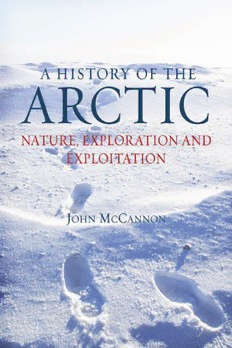
A history of the Arctic nature, exploration and exploitation PDF
Preview A history of the Arctic nature, exploration and exploitation
a histor\ of the arctic A HISTORY OF THE ARCTIC NATURE, EXPLORATION AND EXPLOITATION JOHN MCCANNON reaktion books With love to Pam and Miranda Published by Reaktion Books Ltd 33Great Sutton Street London ec1v 0dx, uk www.reaktionbooks.co.uk First published 2012 Copyright © John McCannon 2012 All rights reserved No part of this publication may be reproduced, stored in a retrieval system, or transmitted, in any form or by any means, electronic, mechanical, photocopying, recording or otherwise, without the prior permission of the publishers. Printed and bound by TJ International, Padstow, Cornwall British Library Cataloguing in Publication Data McCannon, John, 1967– A history of the Arctic: nature, exploration and exploitation. 1. Arctic regions –History. 2. Arctic regions –Discovery and exploration –History. 3. Arctic regions –Climate. 4. Arctic regions –Environmental conditions. 5. Geopolitics –Arctic regions. I. Title 998-dc23 isbn978 1 78023 018 4 Contents 1 Origins: Introduction and Environmental Overview 7 2 Encounters: Prehistory and Early History to 1500 ce 27 3 Incursions: 1500 to 1800 77 4 Crusades: 1800 to 1914 125 5 Subjugations: 1914 to 1945 193 6 Contaminations: 1945 to 1991 236 7 Extinctions? 1991 to the Present 279 references 309 bibliography 319 acknowledgements 329 photo acknowledgements 331 index 333 Circumpolar view of the Arctic. 1 Origins: Introduction and Environmental Overview In July 1895, after months of allowing his research vessel, the Fram, to drift through the pack ice of the Arctic Ocean, Fridtjof Nansen of Norway caught sight of land for the first time in almost two years. Finally, he exclaimed, ‘we again see something rising above that never- ending white line on the horizon yonder – a white line which for count- less ages has stretched over this lonely sea, and which for millennia to come shall stretch in the same way.’ For the crew of the Fram, to be where the human eye could once more perceive topographical difference was to recover the human sense of passing time, an experience Nansen likened to starting ‘a new life’. ‘For the ice’, by contrast, every moment was, and ever would be, ‘the same’.1 Throughout recorded history, wilderness in many forms has served to symbolize elemental vastness and permanence. The forest primeval. The earth-rooted mountain. Boundless steppes and limitless seas. That said, perhaps no landscape has stood out in the modern mind as so quintessentially timeless as the Arctic. In the Western imagination, the polar world has featured as a realm of crystalline purity, as a grey kingdom of frozen death, and in other guises besides, but is most often seen as eternal and unchanging. Nansen described it further as ‘so awfully still, with the silence that shall one day reign, when the earth again becomes desolate and empty’ – making him merely one of dozens who essentialize the Arctic, even if just for poetic effect, as an ageless expanse marked solely by the inexorable encroachment of glaciers upon the land, the mesmerizing shimmer of the aurora borealis, and endless cycles of migration leading polar bears, reindeer and whales in never-varying circles over the earth and through the ocean depths.2 7 a history of the arctic The North American Arctic and Greenland. But the Arctic, of course, does change. Like all places, it moves through time, shaped by natural forces and human agency alike. Also, to those who live there or pay it close attention, it presents more faces than it is commonly thought to have. The American explorer Elisha Kent Kane cleaved to the standard view in his Grinnell expedition diaries, declaring the Arctic ‘a landscape such as Milton or Dante might imagine: inorganic, desolate, mysterious . . . unfinished by the hand of its Creator’ – whereas the Canadian naturalist Farley Mowat insists that ‘the Arctic is not only the ice-covered cap of the world’ or ‘the absolute cold of the pole’, but also ‘two million square miles of rolling plains that, during the heat of midsummer, are thronged with life and brilliant with the colors of countless plants in full bloom’.3 The purpose of this book is to portray these many visages and to trace the Arctic’s passage through time as fully as possible. Both tasks necessitate the weaving together of many narratives, for ‘Arctic history’ encompasses not just the oft-repeated chronicle of polar exploration, but processes of national development, economic organization and resource mobilization. It is the still-undervalued tale of the peoples indigenous to the Arctic and their frequently painful interactions with Euro-American outsiders and colonizers. It is bound up with the histories of science, technology, diplomacy and war. It demands an appreciation of the environment’s climatological and zoological 8
